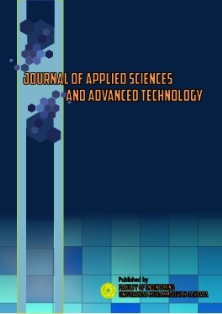Efficiency Analysis of Ripple Mill Capacity 6 Ton/Hours on Maintenance Machine
DOI:
https://doi.org/10.24853/jasat.6.2.75-82Kata Kunci:
Ripple Mill, Nut & Kernel, Machine Performance Efficiency, Ripple Mill Working HoursAbstrak
Ripple mill is a machine used to crush palm kernels at the nut & kernel station. This research aims to find out how the ripple mill machine works and determine the relationship between machine maintenance carried out on the performance efficiency of the ripple mill. The working principle of a ripple mill is that palm kernels that are fed into the ripple mill will be ground and crushed between the rotor and stator with an engine speed of 1200 rpm. The components contained in the ripple mill are the rotor bar which consists of 40 bars arranged in a circle, the stator bar consists of 18 bars at the front and 18 bars at the back, the v-belt pulley used is of the type B65 and B67 according to the position of the motor, then the flange bearing is used as a position for the shaft on the rotor before connecting to the pulley. Based on the results of research that has been carried out, it was found that the feed entering the ripple mill is 5.6 tons / hour with an installed capacity of 6 tons / hour. The working hours that have been set for the ripple mill are 300 operating hours, after observations it was obtained that it was 320 operating hours with the efficiency results obtained remaining in accordance with the predetermined standards, namely 95% - 99%.Unduhan
Referensi
Gee, P. T. (2007). Analytical characteristics of crude and refined palm oil and fractions. European journal of lipid science and technology, 109(4), 373-379.
Rahardja, I. B., & Darmawan, A. (2020). The Effect of Oil Thickness in the Cylindrical Settling Tank on the Moisture and Impurities of Crude Palm Oil (CPO). Journal of Applied Sciences and Advanced Technology, 3(1), 21-28.
Rahardja, I. B., Daraquthni, Z., & Ramadhan, A. I. (2019). Potential of palm oil solid waste as steam power fuel (case study at XYZ palm oil mill). Journal of Applied Sciences and Advanced Technology, 2(2), 33-38.
Rahardja, I. B., Afifah, H., Dermawan, Y., Diniardi, E., Ramadhan, A. I., & Siregar, J. P. (2021). Mechanical Properties of Particle board from Empty Palm Fruit with Polyester Resin Adhesive. Journal of Applied Sciences and Advanced Technology, 4(1), 35-42.
Obibuzor, J. U., Okogbenin, E. A., & Abigor, R. D. (2012). Oil recovery from palm fruits and palm kernel. In Palm Oil (pp. 299-328). AOCS Press.
Poku, K. (2002). Small-scale palm oil processing in Africa (No. 148). Food & Agriculture Org..
Harahap, M. A., Haeruman, A., & Mokheimer, E. (2023). Optimal Composition of Palm Oil Biomass to Minimize Biomass Power Plants’ Greenhouse Gases Emission. ASME Open Journal of Engineering, 2.
Arysadiaga, Duhan. 2018. Analysis of Determining Machine Maintenance Time Using the RCM (Reability Centered Maintenance) Method at PT SANMAS DWIKA ABADI. University August 17th. Jakarta.
John, Inyang, et al. "A model to manage crude palm oil production system." MATEC Web of Conferences. Vol. 255. EDP Sciences, 2019.
Setyaningsih, D., Fahma, F., Wahyudi, A. T., & Mahendra, I. B. (2022, June). Technology innovation and business model of palm oil miniplant for food and energy. In IOP Conference Series: Earth and Environmental Science (Vol. 1034, No. 1, p. 012061). IOP Publishing.
Hikmawan, O., Naufa, M., & Indriani, B. M. (2021). Pengaruh jarak rotor terhadap efisiensi pemecahan biji pada stasiun ripple mill di pabrik kelapa sawit. Jurnal Teknik Dan Teknologi, 16(31), 14-21.
Hamdy, M. I., & Azizi, A. (2017). Analisis nilai Overall Equipment Effectiveness (OEE) pada mesin ripple mill. Jurnal Teknik Industri, 3(1).
Perkebunan, S. T. I. P. A. (2015). Analisa Hasil Cracked Mixture Pada Alat Pemecah Biji (Ripple Mill) Kelapa Sawit Kapasitas 250 Kg/Jam. Jurnal Penelitian STIPAP, 6(1).
Saraswati, A. (2012). Teknik Minimalisasi Kernel Losses di Claybath Pabrik Pengolahan Kelapa Sawit. JURNAL CITRA WIDYA EDUKASI, 4(1), 43-48.
KUNCORO, G. M. S. (2013). PERENGKAHAN MINYAK KELAPA SAWIT MENGGUNAKAN VARIASI CAMPURAN KATALIS Ni/AlMCM-41, H-AlMCM-41 DAN BENTONIT; CRACKING OF PALM OIL USING VARIATION OF MIXTURE OF Ni/AlMCM-41, H-AlMCM-41 AND BENTONITE CATALYSTS (Doctoral dissertation, Universitas Gadjah Mada).
Lesmana, A. (2021). Analisis Hasil Kinerja Mesin Ripple Mili di Stasiun Pengolahan Biji Pabrik Kelapa Sawit (Doctoral dissertation, Universitas Medan Area).
Hikmawan, O., Naufa, M., & Indriani, B. M. (2021). Pengaruh jarak rotor terhadap efisiensi pemecahan biji pada stasiun ripple mill di pabrik kelapa sawit. Jurnal Teknik Dan Teknologi, 16(31), 14-21.
Brown, N. P., Koretz, J. F., & Bron, A. J. (1999). The development and maintenance of emmetropia. Eye, 13(1), 83-92.
Prajapati, A., Bechtel, J., & Ganesan, S. (2012). Condition based maintenance: a survey. Journal of Quality in Maintenance Engineering, 18(4), 384-400.
Basri, E. I., Razak, I. H. A., Ab-Samat, H., & Kamaruddin, S. (2017). Preventive maintenance (PM) planning: a review. Journal of quality in maintenance engineering, 23(2), 114-143.
Wang, Y., Deng, C., Wu, J., Wang, Y., & Xiong, Y. (2014). A corrective maintenance scheme for engineering equipment. Engineering Failure Analysis, 36, 269-283.
##submission.downloads##
Diterbitkan
Terbitan
Bagian
Lisensi
COPYRIGHT POLICY
The author(s) of an article published in the Journal of Applied Sciences and Advanced Technology (JASAT) retains ownership of the intellectual property rights in work (s).
PUBLISHING RIGHTS
The author(s) of an article published in the Journal of Applied Sciences and Advanced Technology (JASAT) have unrestricted publication rights. The authors give the Journal of Applied Sciences and Advanced Technology (JASAT) the right to publish the article and designate the Faculty of Engineering Universitas Muhammadiyah Jakarta Publishing as the original publisher of the article.
LICENSING POLICY
JASAT is an open-access journal that follows the Creative Commons Non-Commercial 4.0 International License (CC BY-NC 4.0), which states that:

Under this license, the reusers must give appropriate credit, provide a link to the license, and indicate if changes were made. Users may do so in any reasonable manner, but not in any way that suggests the licensor endorses users or their use.
Please take the time to read the whole license agreement (https://creativecommons.org/licenses/by-nc/4.0/). As long as reusers follow the license conditions, the owner cannot withdraw these freedoms. The following components are included under this license:
 Attribution: Users must provide appropriate attribution, including a link to the license, and indicate whether or not they made any modifications. Users are free to do so reasonably, but not in a manner that indicates the licensee approves of their usage.
Attribution: Users must provide appropriate attribution, including a link to the license, and indicate whether or not they made any modifications. Users are free to do so reasonably, but not in a manner that indicates the licensee approves of their usage.
 NonCommercial: Users may not use the material for commercial purposes.
NonCommercial: Users may not use the material for commercial purposes.












_2.png)


1.png)

2.png)
